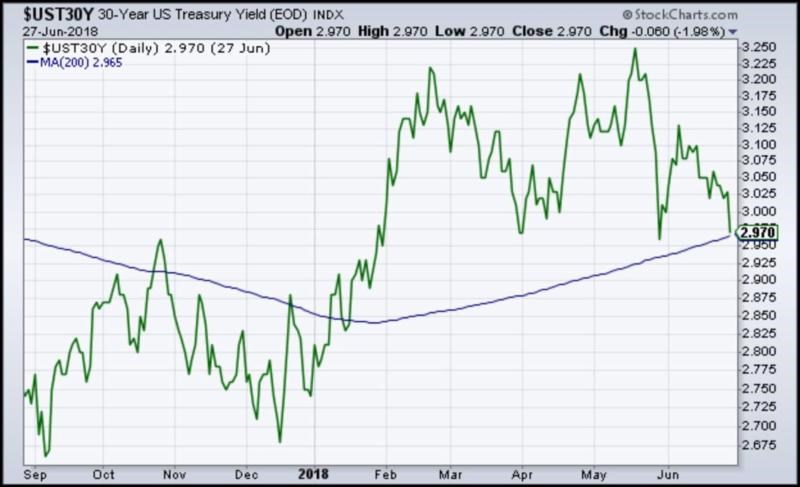HORTER INVESTMENT MANAGEMENT, LLC
Weekly Commentary horterinvestment.com July 2, 2018
US Recession Odds Surging
On paper, the odds of a recession have never looked very high. It is only human instinct that makes many believe that is where we may be headed. However, that is starting to change. Since the Financial Crisis, the odds of a recession in the next 12 months held very low, around 5%. However, they have just jumped to 16% according to a popular recession calculator from BBVA. The last time the figure was higher was during the last recession. The two big factors boosting the odds are the US’ flattening yield curve as well as the threat of a trade war, which is hard for anyone to gauge. According to an economist at BAML, “Our calculations suggest that a major trade war would lead to
a significant reduction in growth … A decline in confidence and supply chain disruptions could amplify the trade shock, leading to an outright recession”.

The Dow’s Drop Was Just the Beginning
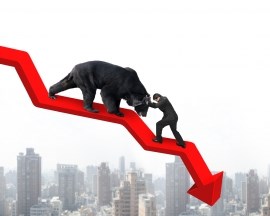
FINSUM: This is a very ugly, but realistic, prediction. We are increasingly worried about the direction of the international dispute on trade.
The Dow had a very ugly day yesterday, as did the Nasdaq and S&P 500. However, that might just be the beginning, argues Barron’s. Markets plunged as Trump escalated the trade stand-off with China and other US trading partners, including limiting Chinese investment in American technology companies. And while markets have been looking at a possible trade war for months, it seems as though they have not fully priced in one of the magnitude which now looks to be emerging. Ac-cording to one analyst, “Markets are starting to price in the possibility of a trade war with China, however, I would argue that a true trade war–one that drives us into a worldwide recession–would lead to a 20% or more drop in prices, so we haven’t priced one in yet”

Taking a comprehensive look at the overall current stock market
Taking a comprehensive look at the overall current stock market, you can see the chart below representing eight major indices and their returns through the week ending June 29, 2018. In a truly diversified portfolio, the portfolio’s total return is determined by the performance of all of the individual positions in combination – not individually.
So, understanding the combined overall performance of the indices below, simply average the 6 indices to get a better overall picture of the market. The combined average of all 6 indices is 0.44% year to date.
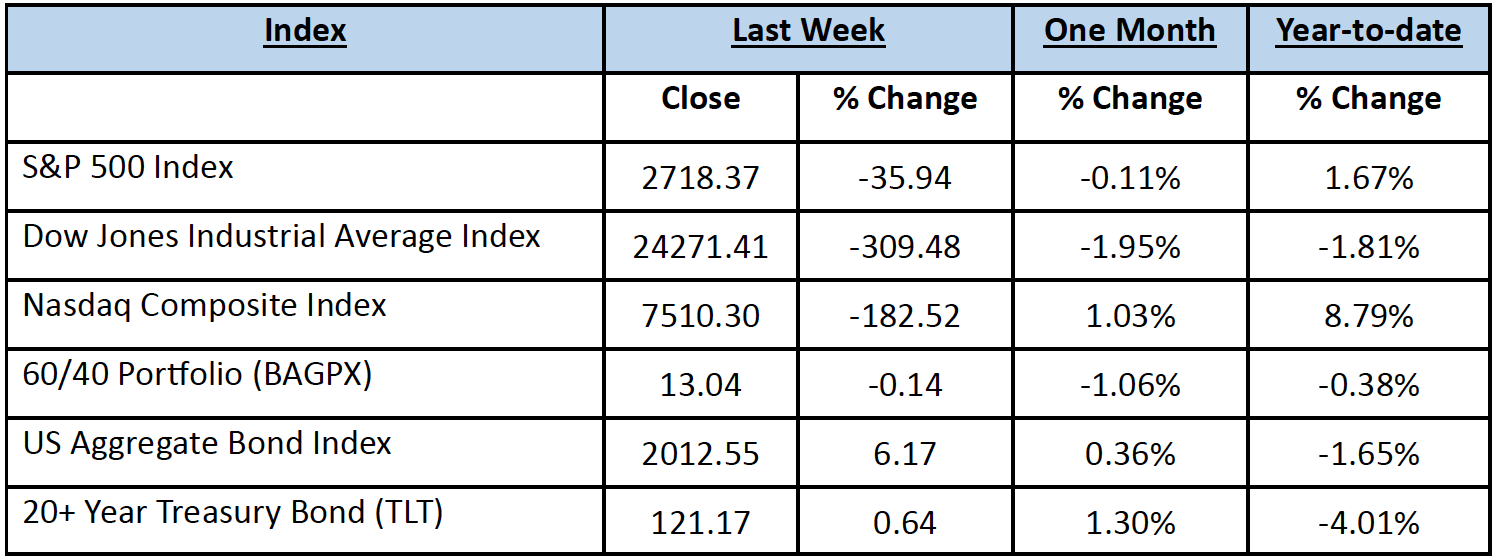
Data Source: Investors FastTrack, Yahoo Finance

Past performance is not a guarantee of future results. This Update is limited to the dissemination of general information pertaining to its investment advisory services and is not suitable for everyone. The information contained herein should not be construed as personalized investment advice. There is no guarantee that the views and opinions expressed in this newsletter will come to pass. Investing in the stock and bond markets involves gains and losses and may not be suitable for all investors. Information presented herein is subject to change without notice. Horter has experienced periods of underperformance in the past and may also in the future. The returns represented herein are total return inclusive of reinvesting all interest and dividends.
The above equity, bond and cash weightings are targets and may not be the exact current weightings in any particular client account. Specifically, there may be cases where accounts hold higher cash levels than stated in these target weightings. This is usually to accommodate account level activity. Furthermore, some variable annuity and variable universal life accounts may not be able to purchase the exact weightings that we are indicating above due to specific product restrictions, limitations, riders, etc. Please refer to your client accounts for more specifics or call your Horter Investment Management, LLC at (513) 984-9933.
Investment advisory services offered through Horter Investment Management, LLC, a SEC-Registered Investment Advisor. Horter Investment Management does not provide legal or tax advice. Investment Advisor Representatives of Horter Investment Management may only conduct business with residents of the states and jurisdictions in which they are properly registered or exempt from registration requirements. Insurance and annuity products are sold separately through Horter Financial Strategies, LLC. Securities transactions for Horter Investment Management clients are placed through TCA by E*TRADE, TD Ameritrade and Nationwide Advisory Solutions.
For additional information about Horter Investment Management, LLC, including fees and services, send for our disclosure statement as set forth on Form ADV from Horter Investment Management, LLC using the contact information herein. Please read the disclosure statement carefully before you invest or send money.
Dow Jones – Week Ending
WEEKLY MARKET SUMMARY
Global Equities: In a reversal from the prior week, the Nasdaq Composite Index led all three major US equity indices into the red for the week as the tech-heavy index started to feel the pain from effects of the trade war. The defensive Utilities sector, once again, outperformed all major S&P 500 sectors, with the Utilities SPDR Select Sector ETF (XLU) gaining 2.38% for the week. International equities continued their recent struggles, as the iShares MSCI Emerging Markets Index ETF (EEM), and the International Developed market iShares MSCI EAFE Index Fund ETF (EFA) were both down over 1%.
Fixed Income: Treasury yields declined slightly, with the yield on the benchmark US 10-Year Treasury Note ending the week around 2.84%. Domestic high yield bond spreads spiked from 3.39% the prior week to 3.64% in a busy week for new issuance. For the remainder of the year, high yield issuance should be light per Wells Fargo’s latest forecast, which revised the projected 2018 total down from $305 billion to just $175 billion. High yield bond mutual funds and ETFs reported a pickup in outflows during the weekly period ended June 27th, losing $1.135 billion, per Lipper.
Commodities: Oil prices continued the upward swing from the prior week’s clarification from the OPEC meeting on production limits. The steady climb in prices is concurrent with a tightening of the Brent Crude/West Texas Intermediate spread, despite US oil exporting a record 3 million barrels per day. Only Saudi Arabia and Iraq are exporting more oil to international markets. The American benchmark West Texas Intermediate gained over 7% for the week, to close near $74 per barrel, while Brent Crude ended the week knocking on the door of $80. Natural Gas prices declined marginally to close the week near $2.92/MMBtu.
WEEKLY ECONOMIC SUMMARY
Personal Income & Outlays: This important report released by the Bureau of Economic Analysis (BEA) indicated that the month-on-month (MoM) measure for personal income increased by .4% for May, as the component for salaries and wages increased a solid .3%. A pop in the savings rate, to 3.2%, explains weakness in consumer spending which came in below expectations for the period, at .2% MoM. Most importantly, the Federal Reserve’s (Fed) preferred measure of inflation, Core Personal Consumption Expenditures (Core PCE), is directly at the Fed’s 2% year-on-year (YoY) target. While the Fed wishes to protect against any additional accelerating inflation, the current rate facilitates continuing on the projected path of gradual increases.
Durable Goods Orders: Orders for durable goods, items that are meant to last for three years or more such as appliances and aircraft, dropped .6% in May in line with consensus estimates. The data from the prior month was revised higher, however, from -1.7% to -1% as business spending is still pretty strong despite the high levels in the beginning of 2018 stemming from the tax cuts. Orders for primary metals have fallen during the month, after a post-tariff announcement buying spree, and are important to watch going forward.
Consumer Confidence: The Conference Board-compiled Consumer Confidence Index may be starting to wane, as the latest release for June was below both the prior level and consensus range. The level for the expectations component dropped again and may be showing signs of consumers unease as effects from the trade war become apparent. The current conditions index is relatively unchanged for this period, signaling that consumer spending in the 2nd quarter should be robust, while the absolute value of the headline Consumer Confidence level continues to exhibit strength.
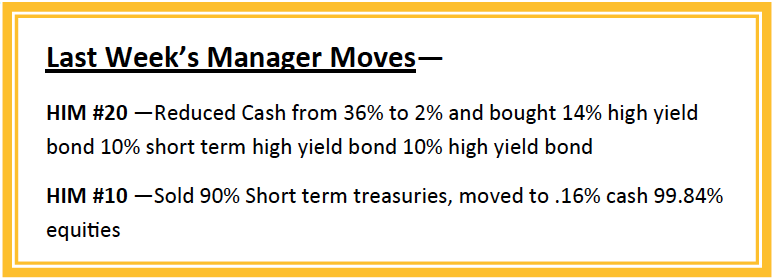
Current Model Allocations
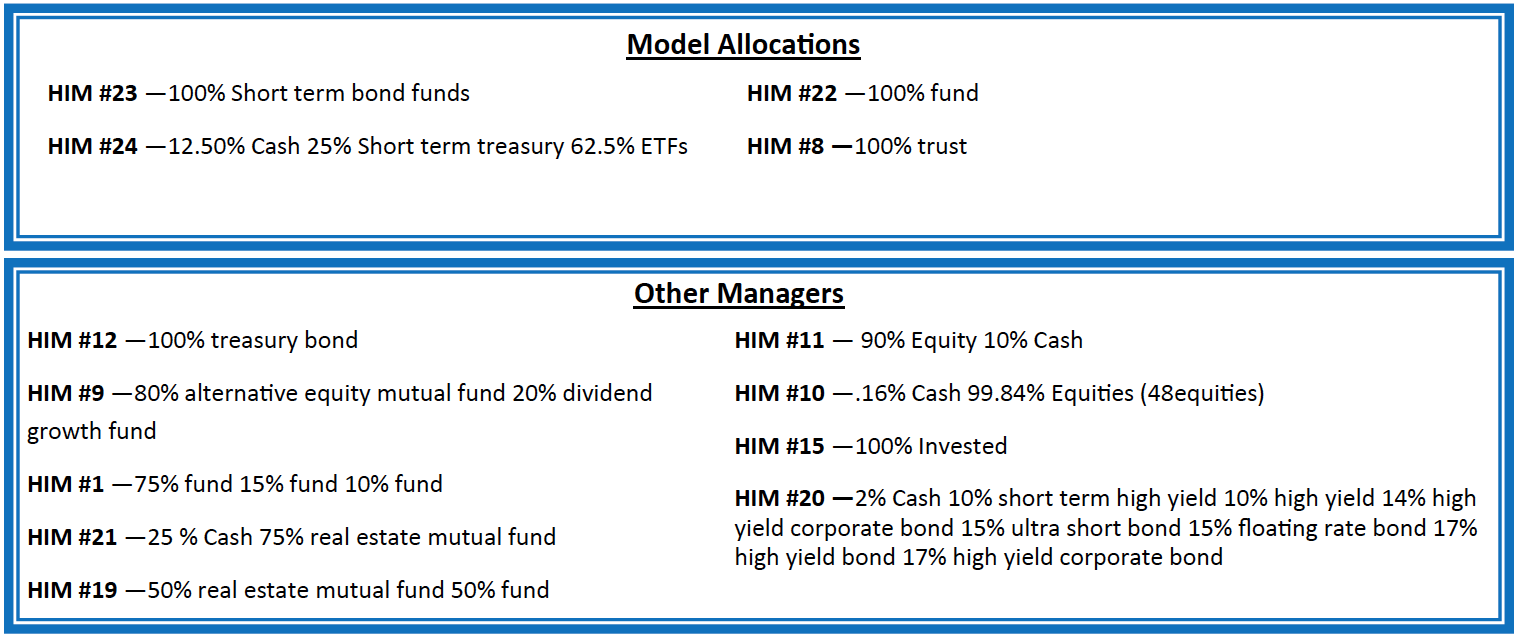
Summary
In utilizing an approach that seeks to limit volatility, it is important to keep perspective of the activity in multiple asset classes. We seek to achieve superior risk-adjusted returns over a full market cycle to a traditional 60% equities / 40% bonds asset allocation. We do this by implementing global mandates of several tactical managers within different risk buckets. For those investors who are unwilling to stomach anything more than minimal downside risk, our goal is to provide a satisfying return over a full market cycle compared to the Barclays Aggregate Bond Index. At Horter Investment Management we realize how confusing the financial markets can be. It is important to keep our clients up to date on what it all means, especially with how it relates to our private wealth managers and their models. We are now in year nine of the most recent bull market, one of
the longest bull markets in U.S. history. At this late stage of the market cycle, it is extremely common for hedged managers to underperform, as they are seeking to limit risk. While none of us know when a market correction will come, even though the movement and volatility sure are starting to act like a correction, our managers have been hired based on our belief that they can accomplish a satisfying return over a full market cycle, — while limiting risk in comparison to a traditional asset allocation approach. At Horter we continue to monitor all of the markets and how our managers are actively managing their portfolios. We remind you there are opportunities to consider with all of our managers. Hopefully this recent market commentary is helpful and thanks for your continued trust and loyalty.
